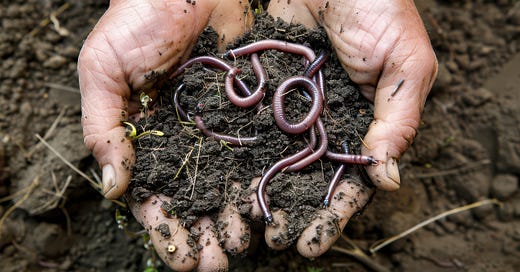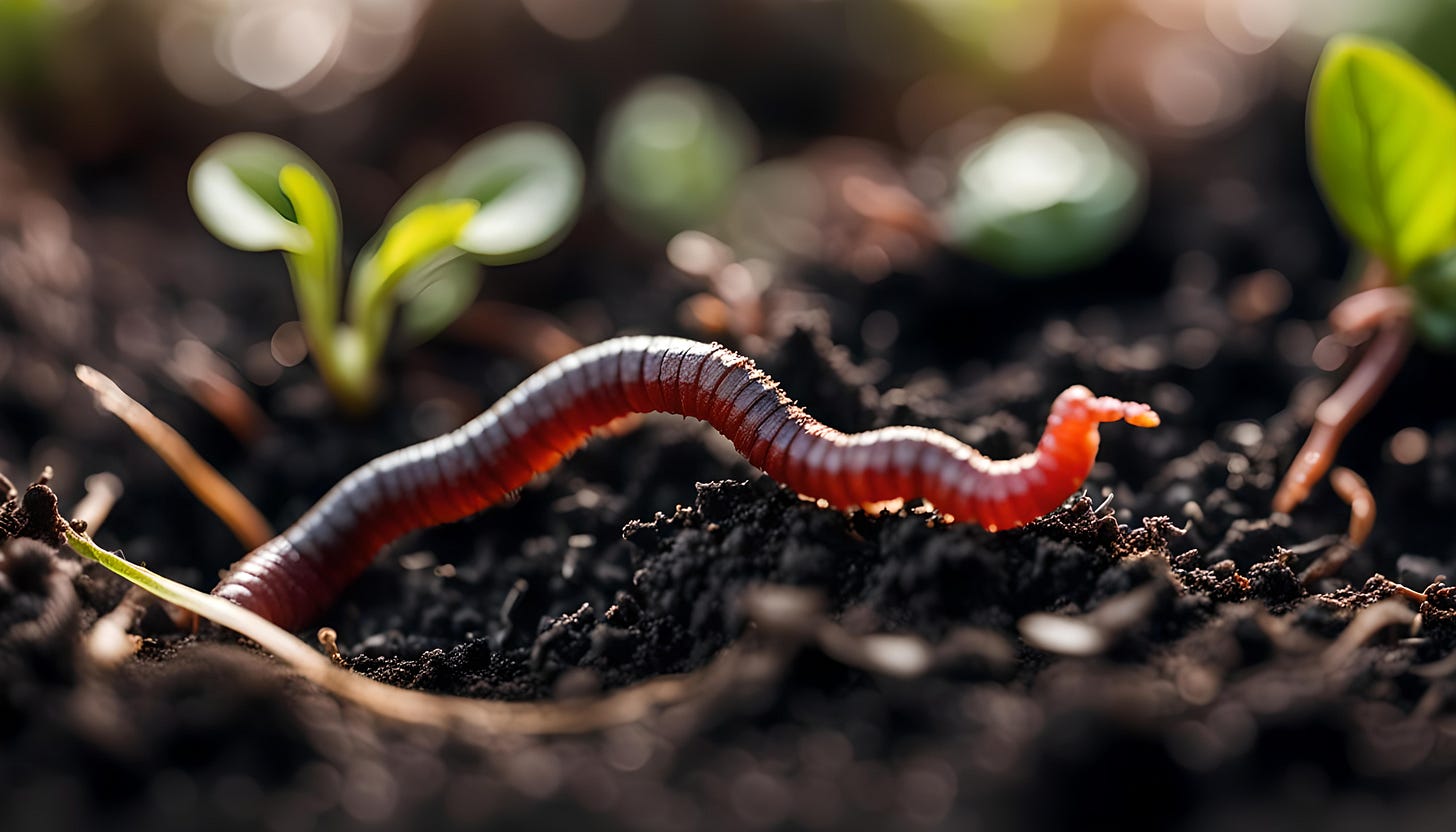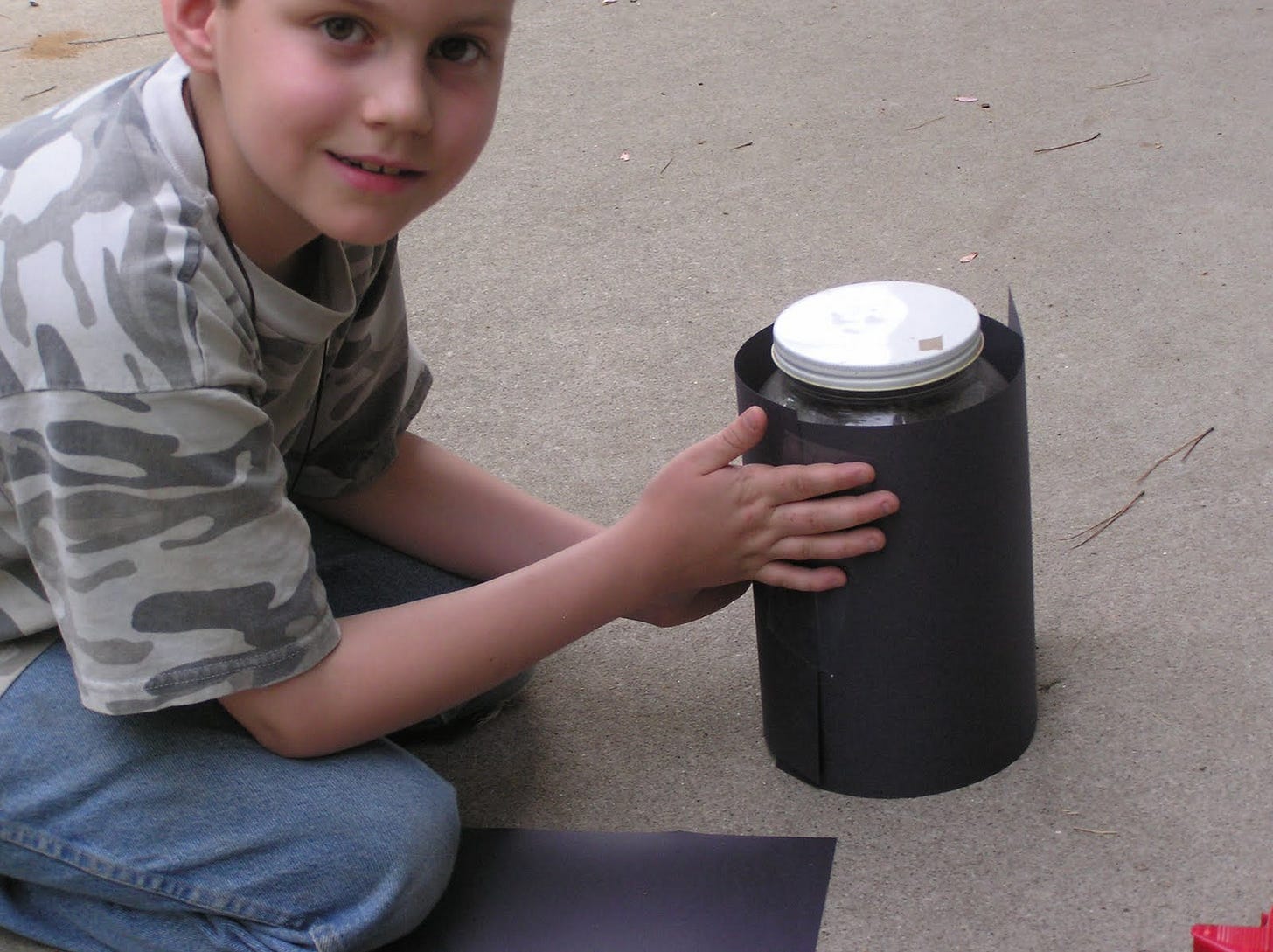🪱The Humble Worm--Hero to the Planet
What every child (and grown-up) should know about this small creature that makes the earth whole.
“The earth, by means of worms, becomes fertile.”
—Pliny the Elder, Natural History (c. 77 AD)
Earthworms—soft-bodied, sightless, and often unseen—are among the most important workers in creation. They recycle decaying matter into rich compost, create airways for roots to breathe, and feed the earth from within. Their work is invisible, yet everything we grow depends on it.
In fact, worms are one of the reasons your garden flourishes, your backyard is full of green life, and your vegetables grow strong and sweet.
They are nature’s hidden keepers of renewal.
Why Worms Matter
Worms are nature’s underground workers. Their job description includes:
Breaking down dead leaves and plants into rich, crumbly compost (called humus)
Tunneling through soil, which brings in air and helps water soak deep into the roots
Feeding plants by releasing nutrients as they eat and digest organic matter
Helping other soil creatures thrive—from microbes to beetles
In other words, they turn death into life, waste into wonder, and dirt into something we can plant and harvest from.
Without worms, the soil would be hard, dry, and lifeless. With worms, it breathes and give nutrients for the plants and trees. And, don’t forget, worms are high protien food for birds!
A Quick Look at Worm Anatomy
Let’s peek inside this small, wriggly master of the soil.
No Eyes, No Ears: Worms don’t see or hear the way we do. Instead, they feel vibrations and sense light through their skin.
Segmented Bodies: Worms are made up of many tiny ring-like segments. These help them move by squeezing and stretching.
Clitellum: This swollen band near the head (looks like a collar) helps the worm reproduce.
No Lungs: Worms breathe through their skin, which is why they need moist soil to survive.
Two Ends, But No Bones: One end is the head (near the clitellum), and the other is the tail. They move by pushing with tiny hairs called setae.
You might say worms are a perfect package of purpose, designed to work below the surface, restoring the earth one wiggle at a time.
Not All Worms Are the Same
Here’s a peek at some of the helpful worm varieties you might meet:
Earthworms – The classic garden worms, often pinkish and long, who live deep in the soil and pull leaves underground to feed on.
Red Wigglers – Small, surface-dwelling worms that love to eat kitchen scraps and are perfect for worm bins and composting.
Night Crawlers – Large and strong, these worms dig deep tunnels and come out mostly at night or after rain.
🌙 Try This: After a gentle rain, take your children outside with a flashlight. Shine it near the grass or garden beds and watch—night crawlers will wriggle to the surface to enjoy the moist air. It’s like a quiet treasure hunt under the stars, and an unforgettable way to connect with the natural world.
The Earthworm’s Gift
A folktale from somewhere green and old
Long ago, when the world was still being shaped, the Great Gardener walked the land. With each step, flowers sprang up. With each breath, trees unfurled their branches. But when the Gardener looked at the soil, it was tired and heavy. Rain pooled on the surface. Roots struggled to reach deep. Seeds waited, but would not grow.
So the Gardener gathered the creatures and asked, “Who among you will go beneath the earth to make it ready for life?”
The fox said, “Not I. The earth is dark, and I love the chase.”
The bird said, “Not I. My wings were made for the sky.”
The ant said, “I already dig, but only for my own kind.”
Then a small, soft voice replied, “I will go.”
All turned to see a little worm—pale, ringed, and quiet.
“I have no claws or wings, no teeth or tail,” said the worm, “but I can slip through the soil. I will go where others will not.”
So the Gardener smiled and gave the worm a gift: the power to breathe through its skin, to eat what others discarded, and to leave behind soil richer than before.
And so the earthworm went below. It turned the soil, softened it with its body, and made room for roots, water, and life. It was never seen, rarely thanked, but everything grew because of it.
To this day, when seeds sprout and roots reach deep, the earth remembers the worm’s promise—and honors its quiet gift.
Start a Worm Farm for STEM Learning (and Wonder)
Want to bring the secret world of worms into view? Try this easy and magical project:
You’ll Need:
A large clear jar (a mason quart jar is ideal)
Layers of soil, sand, and leaf litter or compost
A few worms (red wigglers or earthworms work well)
A strip of black paper or dark cloth
A spray bottle and nature journal
Instructions:
Fill the jar with layers of soil, sand, and leaves.
Gently place your worms on top and lightly mist with water.
Wrap the jar in black paper to block out the light.
After a few days, unwrap it and watch the soil come alive.
Keep watch in the days ahead to see how the worms transform the layers of soil, sand and leaves into rich, dark earth.
Children can draw what they see, name their worms, or write their questions in a nature journal. After a week or two, release the worms gently into your garden, and know you’ve just made the earth a little better.
Free Printable: My Worm Farm
I've created a Nature Card to go with this post—perfect for printing, journaling, or a STEM project. It includes a quote, sketch area, and observation prompts for young naturalists.
👉 Click here to download My Worm Farm - Printable
Coming Soon!
I’m delighted to share that I’ve been working on something special: my new book, Nature Stories and Poems for Children—a gentle, wonder-filled collection of seasonal tales, short nature reflections, and simple poems to read aloud with children. It's designed to nurture observation, curiosity, and a deep love for the natural world. Whether you're curled up on the couch or out beneath a tree, this little book invites children to see beauty in the everyday and mystery in the small.
And in just a few weeks, I’ll be posting a new article all about starting your own worm bin at home—an easy, hands-on way to turn kitchen scraps into garden gold, with help from a few humble, hard-working worms. Perfect for spring learning!
If you’re not already subscribed, be sure to join me here so you don’t miss the next post.
Until then, keep noticing, keep wondering… and maybe, thank a worm today. 🪱
With gratitude,
Sheila Carroll
Living Books Press









I love that story! Worms don't put on airs they just go to work, do their job. I can hear them speaking in a quiet voice from the back of the room 'I will do what needs doing for the good of us all'